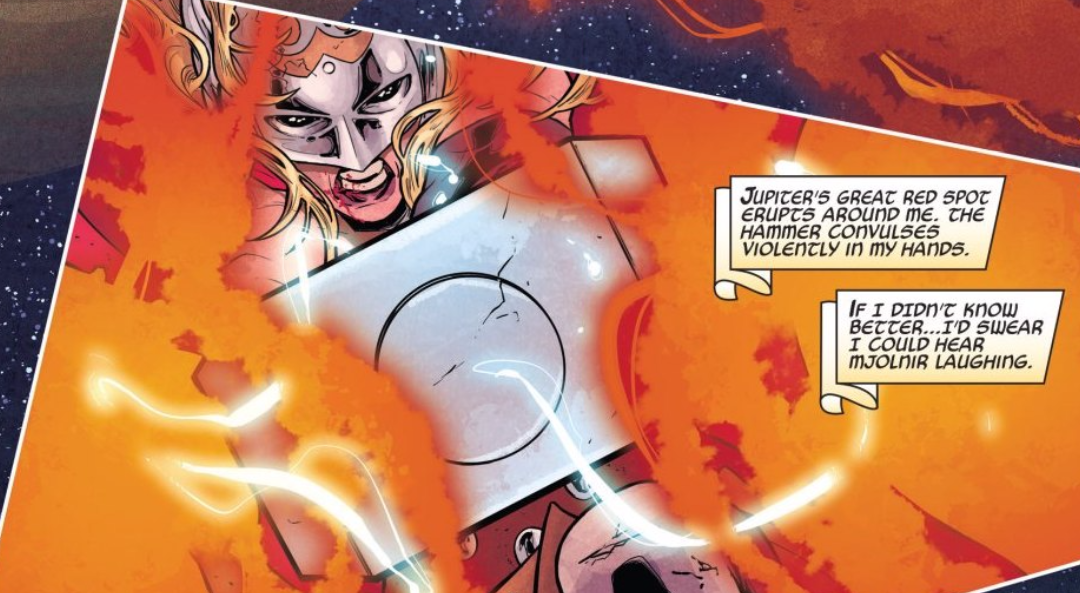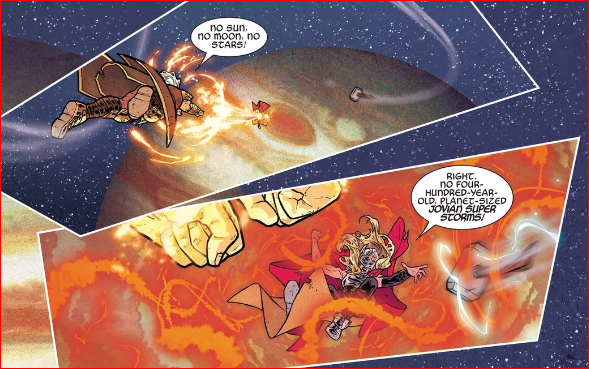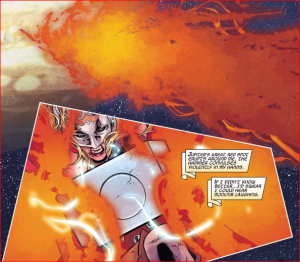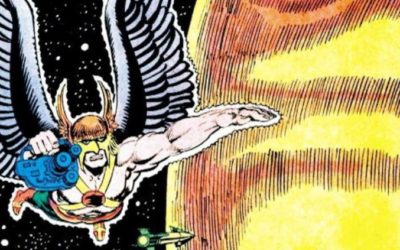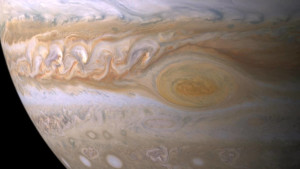
The Great Red Spot is an anticyclone swirling around a center of high atmospheric pressure that makes it rotate in the opposite sense of hurricanes on Earth.
Credits: NASA/JPL/Space Science Institute
If you’ve been keeping up with Marvel’s The Mighty Thor, you know that things between the new(ish), female Thor and Odin aren’t going well. In issue #5 of the series (still available at your local comic shop or online via Comixology) things broke out into a total civil war (no, not that Civil War, or Marvel’s Civil War II coming this summer) that had god fighting god, wife against husband, and as mentioned, Thor vs. Odin.
Credit where it’s due: The Mighty Thor has spectacular art by Russell Dauterman, but he outdid himself with this issue, specifically on the battle between Thor and Odin which raged between Saturn and Jupiter. The upper hand in the battle shifted back and forth between Thor and Odin, but for our money, the best scene came when Thor, knocked back towards Jupiter by Odin, used her hammer Mjolnir, to channel the fury of Jupiter’s Great Red Spot at Odin. The blast was enough to knock Odin back a few thousand kilometers.
Mmmmmm…sweet planetary science.
So what exactly did Thor “throw” at Odin? Let’s look at the science of Jupiter’s Great Red Spot – things aren’t as definite as you might think.
First off – how old is the Great Red Spot? Good question.
Let’s go with Thor’s claim on the age of the “planet-sized Jovian super storm” – about 400 years old. But that’s just one interpretation of the storm’s age. Those in the “400 year-old” camp explain that the Red Spot was first observed by Giovanni Cassini around 1665 through 1731. There’s no doubt that the Red Spot hadn’t just formed when Cassini looked at it, which means that it is most likely older, perhaps much older than 400 years.
The “younger” camp of astronomers points that the Great Red Spot has changed size over the years – and perhaps has even dissipated and re-formed since Cassini first pointed his telescope at Jupiter. Currently at less than 20,000 km wide, the Great Red Spot is less than half as big as it was just 100 years ago, so the thinking goes that the Great Red Spot could be a repeating phenomenon of Jupiter’s atmosphere, forming and dispersing over and over again. In short, we haven’t been watching the Red Spot long enough to determine if there’s a pattern to its shape over time. The Great Red Spot that’s currently on Jupiter is the one that we’ve been observing for nearly 200 years, but it can’t be said with any certainty if it’s the same one Cassini saw in the 17th century.
As Thor also points out, Jupiter’s Great Red Spot is a giant storm – one of many on the planet. The Great Red Spot is the largest and fiercest storm on Jupiter, with winds on its edges hitting speeds of around 400 miles per hour, while winds inside the storm appear to be much slower and even, at times, barely moving. Presumably driven by Jupiter’s internal heat, the Great Red Spot spins in a counter-clockwise direction, making a full rotation every six earth days. Its boundaries are defined by two jet streams in Jupiter’s atmosphere that make the Great Red Spot remarkably stable in its north-south position on the planet, at 22° south of the equator. But the Great Red Spot is free to move east-west, and has circled the planet at least 10 times since the early 1800s.
Getting back to the size, if you could move it, you could put the earth into the Great Red Spot – but again, that’s a shadow of its former self, and the rate of the spot’s shrinkage seems to be accelerating. As of a recent (2014) measurement, it’s 16,496 km wide – and presumably has gotten smaller since. Height-wise, the Great Red Spot’s upper clouds are roughly 8 km higher than the surrounding clouds – think if it as a bump on the planet’s profile. As a result of the height, the clouds that make up the Great Red Spot are colder then the other clouds on the planet’s surface, although lower clouds in the center are warmer.
And then there’s the trouble with the name – the Great Red Spot hasn’t appeared red in the visible part of the spectrum since a period in the mid ‘70s – it’s more of a pale orange, tan or light rust color. Any images you may have seen of it being a brilliant, or at least distinct red are either, a) old, or b) false-color images, with the color added after the image got back from space. Sometimes the spot disappears from the visible spectrum altogether and can only be detected as the Red Spot Hollow – the area it occupies in Jupiter’s South Equatorial Belt.
What makes it red (when it is red) is still up for debate among scientists, with the leading candidate being ammonium hydrosulfide from Jupiter’s atmosphere that gets blasted by radiation, including cosmic rays. The radiation causes the ammonium hydrosulfide to form new compounds which could appear red. But big picture – it’s still not known why the Great Red Spot, when it’s red, is red.
What does all this mean? If you want to stake a claim on the idea that Jupiter’s Great Red Spot is fading away…well, you’re not going to be alone. Time-wise, when might the (current?) spot completely fade away as a storm? That’s hard to say – it’s been shrinking for over a century, but trying to predict the weather on Jupiter is like trying to predict the weather on earth. If you’re trying to predict what the weather will be like in an hour, you’re going to be close or spot on. If you’re trying to predict a storm’s dissipation over the course of years…well, there’s a lot of wiggle room.
But even the simple view of Jupiter’s Great Red Spot fading away opens up the door to many other questions. Going back to our thunder god that got us into this, Thor used the Great Red Spot as a weapon(*) against Odin because it had energy. Storms have energy. Big storms, as wide as the earth have lots of energy. But think about it – Jupiter’s Great Red Spot is shrinking. It’s losing energy.
Why?
On earth, storms lose energy when they go over land. As far as planetary scientists know, there’s no land on Jupiter for the storm to be leeching the storm’s energy. So why is a gigantic storm on a planet far away from us losing energy and shrinking?
Now that’s a good question.
Get to work.
(*) Hey, as always, we’re not here to debate whether or not Thor could have pulled the storm’s energy (and clouds) up away from Jupiter and nail Odin with them. That’s not our bag. As we always contend, the “special effects” of comics are metaphors. Thor is powerful, right? How do you demonstrate that power? Pull a storm off of a planet and send it at the All-father, of course. You get the idea that Thor’s strong, right? The creative team’s mission has been accomplished. Us? We’re just here to talk science.
For more on Jupiter’s Great Red Spot:
Jupiter’s Great Red Spot: A Swirling Mystery
For more Thor-based and Jupiter science:
Getting Thor Back from the Moon – Mjolnir Power!
Shooting Jupiter in Superman – Can You Make a Star?


